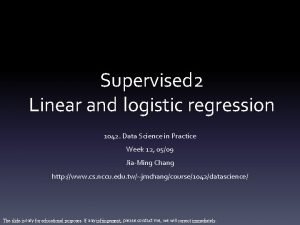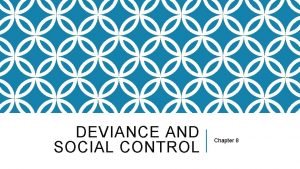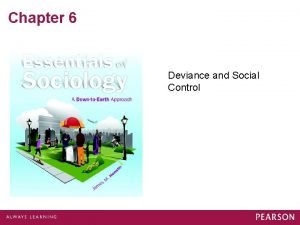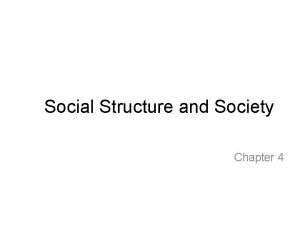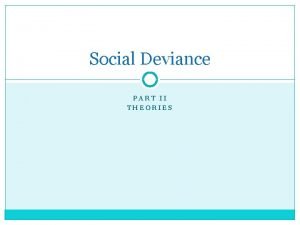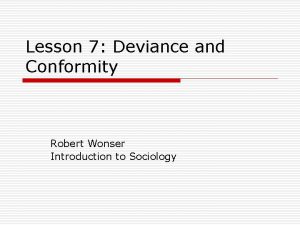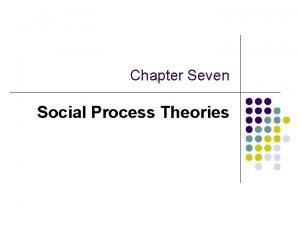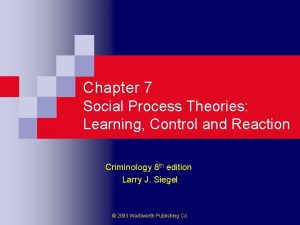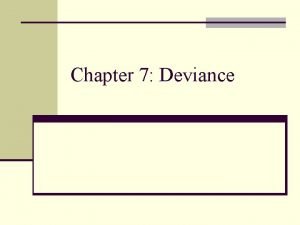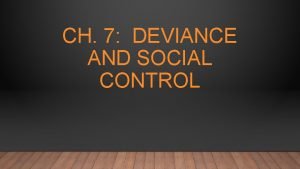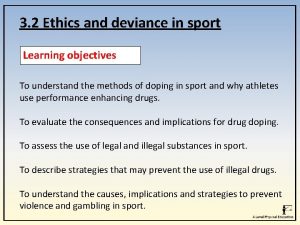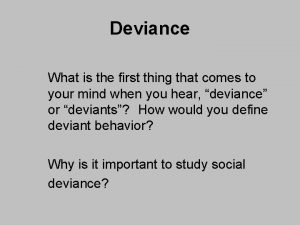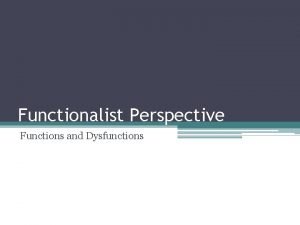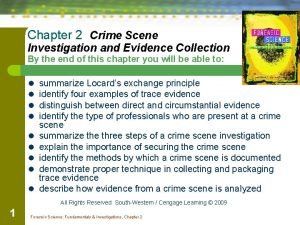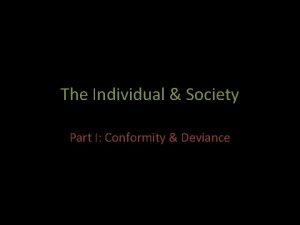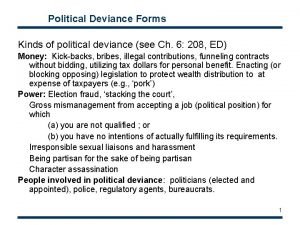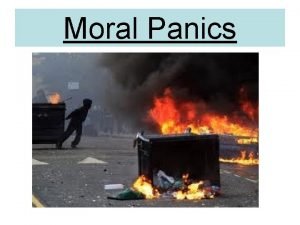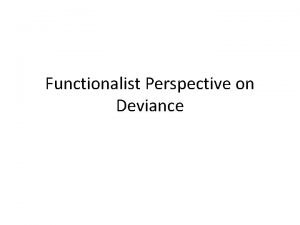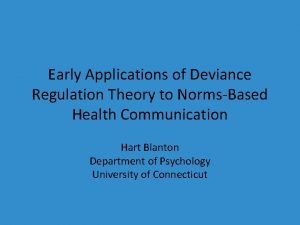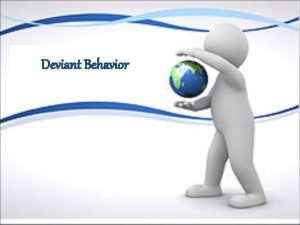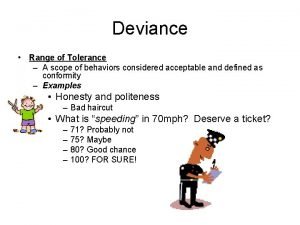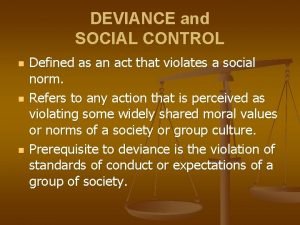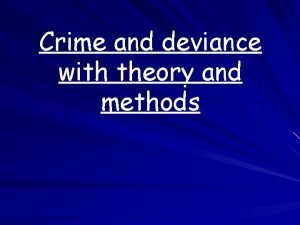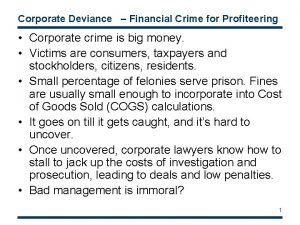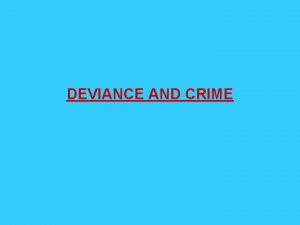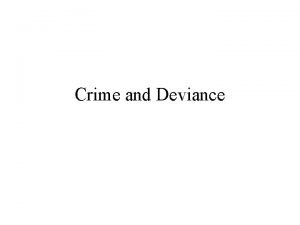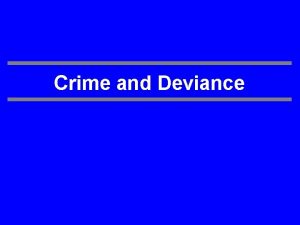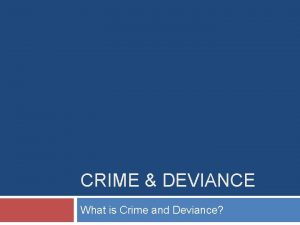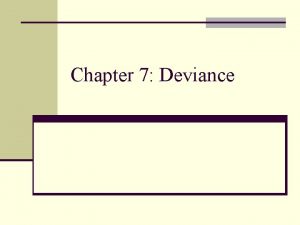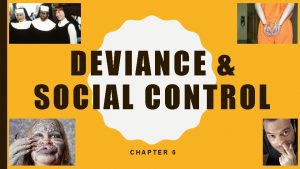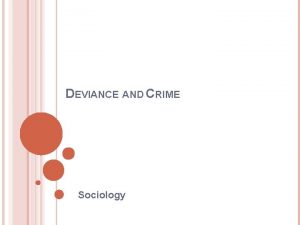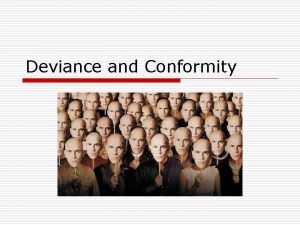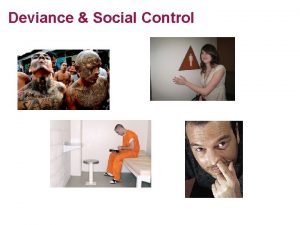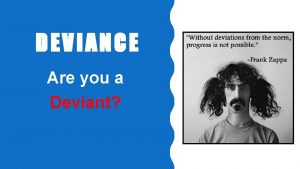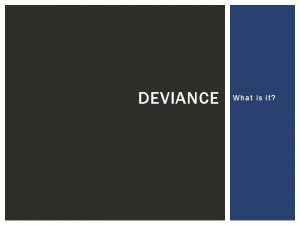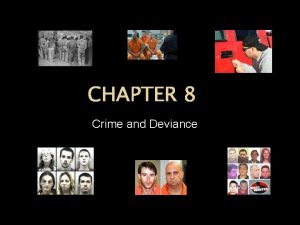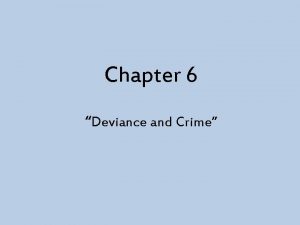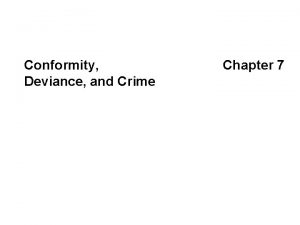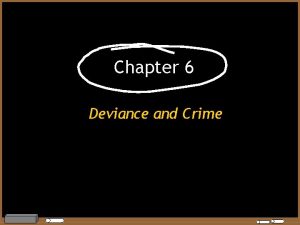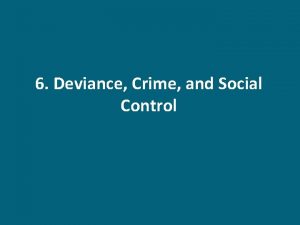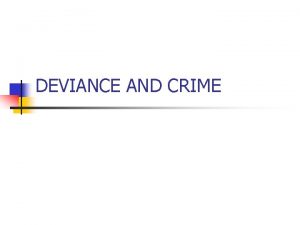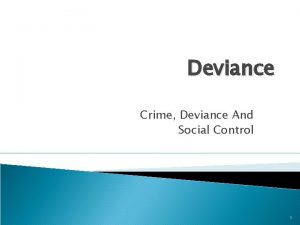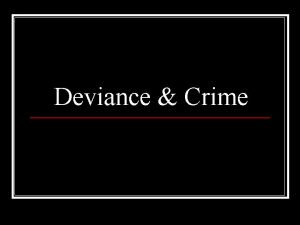Chapter 6 Deviance and Crime Chapter Outline What































- Slides: 31

Chapter 6 Deviance and Crime

Chapter Outline • • • What Is Deviance? Functionalist Perspectives on Deviance Conflict Perspectives on Deviance Symbolic Interactionist Perspectives on Deviance Postmodernist Perspectives on Deviance

Chapter Outline Crime Classifications and Statistics • The Criminal Justice System • Deviance and Crime in the U. S. in the Future • The Global Criminal Economy •

Deviance • Any behavior, belief, or condition that violates social norms in the society or group in which it occurs: – drinking too much – robbing a bank – laughing at a funeral

What Is Social Control? • Practices that social groups develop to encourage conformity to norms, rules, and laws and to discourage deviance.

What Is Social Control? Internal social control takes place when individuals internalize norms and values and follow those norms and values in their lives. • External social control involves negative sanctions that proscribe certain behaviors and punish rule breakers. •

Functionalist Perspective Deviance serves three functions: 1. Deviance clarifies rules. 2. Deviance unites a group. 3. Deviance promotes social change.

Merton’s Strain Theory of Deviance TQ Mode Method Conformity Accepts approved goals, pursues them through approved means. Innovation Accepts approved goals; uses disapproved means. Ritualism Abandons society’s goals; conforms to approved means.

Merton’s Strain Theory of Deviance. TQ Mode Method Retreatism Abandons approved goals and approved means. Rebellion Challenges approved goals and approved means.

Deviant type Goals Means Conformist Yes Innovator Yes No Ritualist No Yes Retreatist or revolutionary No No

Opportunity Theory • Sociologists Richard Cloward and Lloyd Ohlin (1960) suggested that for deviance to occur, people must have access illegitimate opportunity structures: – Circumstances that provide an opportunity for people to acquire through illegitimate activities what they cannot achieve through legitimate channels.

Functionalist Perspectives Theory Strain theory Opportunity theory Key Elements Deviance occurs when approved means of reaching approved goals is blocked. Lower-class delinquents subscribe to middleclass values they can’t attain. They may achieve goals illegitimately.

Functionalist Perspectives Theory Social control/ social bonding Key Elements When ties to family and friends are weak, individuals are likely to engage in criminal behavior.

Interactionist Perspectives Theory Differential association Labeling theory Key element Deviant behavior is learned in interaction with others. Acts are deviant because they have been labeled as such.

Interactionist Perspectives Theory Key element Primary /secondary A person accepts the “deviant” label and continues to engage in “deviant” behavior.

Conflict Perspectives Theory Key Elements Critical approach The powerful use the criminal justice system to protect their interests. Feminist approach Liberal- deviance arises from discrimination. Radical- focuses on patriarchy Socialist - focuses on capitalism and patriarchy

Differential Association Theory Perspectives States that people have a greater tendency to deviate from societal norms when they frequently associate with individuals who are more favorable toward deviance than conformity. • From this approach, criminal behavior is learned within intimate personal groups such as one’s family and peer groups •


Differential Reinforcement Theory • Criminologist Ronald Akers (1998) combined differential association theory with elements of psychological learning theory to create differential reinforcement theory. – If a person’s friends and groups define deviant behavior as “right, ” they are more likely to engage in deviant behavior. – If a person’s friends and groups define deviant behavior as “wrong, ” the person is less likely to engage in that behavior.

Social Bond Theory The probability of deviant behavior increases when a person’s ties to society are weakened or broken. • According to Hirschi, social bonding consists of – attachment to other people – commitment to conformity – involvement in conventional activities – belief in the legitimacy of conventional norms. •

Figure 7. 4 Elements of Social Bond Theory

Labeling Theory States that deviance is a socially constructed process in which social control agencies designate certain people as deviants, and they, in turn, accept the label and begin to act accordingly. • Focuses on the variety of symbolic labels that people are given in their interactions with others. • The act of fixing a person with a negative identity, such as “criminal” is directly related to the power of those who do the labeling and those being labeled. •

Postmodern Perspective Theory Key Element Power, knowledge, and social control are intertwined. Knowledge is power Example: Methods of prison surveillance make prisoners think they are being watched all the time, giving officials power over the inmates.

Stages in the Labeling Process If individuals accept a negative label, they are more likely to continue to participate in the type of behavior the label was initially meant to control. • Secondary deviance occurs when a person who has been labeled a deviant accepts the identity and continues the deviant behavior. • Tertiary deviance occurs when a person who has been labeled a deviant seeks to normalize the behavior by relabeling it as nondeviant. •


How the Law Classifies Crime • Crimes are divided into felonies and misdemeanors. – A felony is a serious crime such as rape, homicide, or aggravated assault, for which punishment typically ranges from more than a year’s imprisonment to death. – A misdemeanor is a minor crime typically punished by less than one year in jail.

How Sociologists Classify Crime • Sociologists categorize crimes based on how they are committed and how society views the offenses: 1. conventional (street) crime 2. occupational (white-collar) and corporate crime 3. organized crime 4. political crime

Functions of Punishment Retribution – The punishment should fit the crime. • Social protection – Restrict offenders so they can’t commit further crimes. •

Functions of Punishment Rehabilitation – Return offenders to the community as lawabiding citizens. • Deterrence – Reduce criminal activity through a fear of punishment. •

Global crime The 1994 United Nations Conference on Global Organized Crime estimated that about $500 billion per year is accrued in the global trade in drugs alone. • Today, profits from all kinds of global criminal activities are estimated to range from $750 billion to more than $1. 5 trillion a year. •

Reducing Global Crime • Requires a global response, including: – Cooperation of law enforcement agencies, prosecutors, and intelligence services across geopolitical boundaries. – Regulation by the international community to control international money laundering and trafficking in people and controlled substances such as drugs and weapons.
 Chapter 7 deviance crime and social control
Chapter 7 deviance crime and social control Null deviance vs residual deviance
Null deviance vs residual deviance Crime and deviance sociology revision
Crime and deviance sociology revision Difference between crime and deviance
Difference between crime and deviance Myra mawby
Myra mawby Marxism crime and deviance
Marxism crime and deviance Deviants chapter 8
Deviants chapter 8 Chapter 6 deviance and social control
Chapter 6 deviance and social control Paragraph sandwich example
Paragraph sandwich example Primary and secondary deviance
Primary and secondary deviance Differential association example
Differential association example Lesson quiz 7-1 deviance and social control
Lesson quiz 7-1 deviance and social control Primary deviance
Primary deviance Primary and secondary deviance
Primary and secondary deviance Primary deviance definition
Primary deviance definition Social control and deviance guided reading section 1
Social control and deviance guided reading section 1 Deviance in sport
Deviance in sport What is secondary deviance
What is secondary deviance Deviant examples
Deviant examples Strain theory examples
Strain theory examples Chapter 2 crime scene investigation and evidence collection
Chapter 2 crime scene investigation and evidence collection Conformity deviance example
Conformity deviance example What is political deviance
What is political deviance Deviancy amplification
Deviancy amplification Normalization of deviance ppt
Normalization of deviance ppt Functionalist perspective on deviance
Functionalist perspective on deviance Deviance regulation theory
Deviance regulation theory Deviance examples
Deviance examples Example of deviance
Example of deviance Criminal deviance
Criminal deviance Strain theory sociology
Strain theory sociology Financial crime
Financial crime

